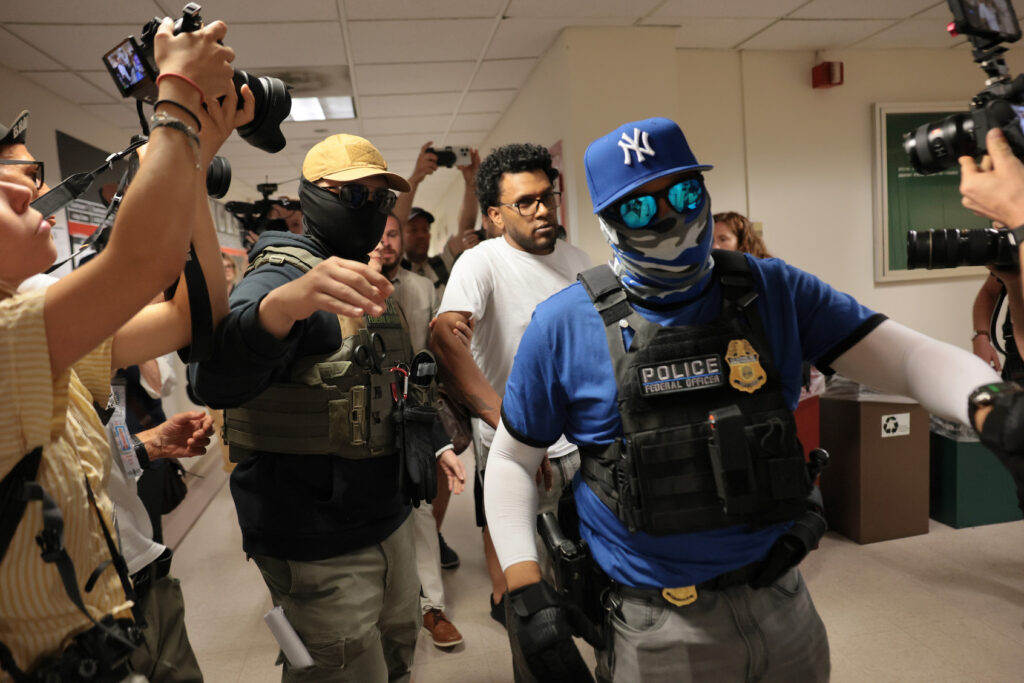
NEW YORK, NEW YORK - JULY 30: Federal agents detain a man after exiting a court hearing in immigration court at the Jacob K. Javitz Federal Building on July 30, 2025 in New York City. U.S. Immigration and Customs Enforcement (ICE) agents continue to make detainments at immigration courts as people attend routine check-ins or show up to court for their immigration hearings. Border czar Tom Homan said he is going to "flood" sanctuary cities, including New York City, with more ICE agents. (Photo by Michael M. Santiago/Getty Images)
Residents of Santa Ana, California, experienced widespread panic in June when officers from Immigration and Customs Enforcement (ICE) conducted aggressive operations in the area. Calls flooded into the city’s emergency response system, with several residents fearing they were witnessing kidnappings as masked individuals in unmarked vehicles forcibly apprehended people. The situation raised serious concerns about accountability and transparency within federal law enforcement agencies.
Calls to local authorities described scenes of chaos. One caller reported seeing a man beaten and pushed into a van lacking identification. A woman questioned, “What kind of police go around without license plates?” The alarming scenes prompted Santa Ana Mayor Valerie Amezcua and the City Council to hold a public meeting, where they asked their police chief for ways to limit federal agents’ activities. Unfortunately, they received little assurance, as accountability measures were practically nonexistent.
The mayor expressed her dismay at the lack of constraints on federal agents who operate under the directives of President Donald Trump and his administration’s aggressive deportation policies. She conveyed her belief that Santa Ana serves as a testing ground for more extensive and violent operations in cities like Chicago. “It’s almost like he tries it out in this county and says, ‘It worked there, so now let me send them there,’” Amezcua noted.
Concerns extend beyond local borders, with current and former national security officials expressing alarm over the evolving role of ICE. They argue that the agency has morphed into a national police force that operates without the checks and balances traditionally seen in the United States. ICE officers now frequently wear masks and operate anonymously, undermining public trust and raising fears reminiscent of repressive regimes.
The rapid transformation of ICE has been facilitated by swift changes within the Department of Homeland Security (DHS). Under Trump’s administration, civil rights protections were dismantled, and oversight mechanisms that once held agents accountable were significantly weakened. The Office for Civil Rights and Civil Liberties, responsible for investigating allegations of misconduct, has seen its functions severely curtailed. Former staff members indicate that the office was dismantled under the guidance of Kristi Noem, the Secretary of Homeland Security, who claimed that it had impeded operations.
As a result of these changes, ICE has received a budget increase, with an annual operating budget of $10 billion and an additional $7.5 billion allocated over four years for recruitment and retention efforts. This funding is part of a broader initiative to expand the agency’s footprint, including lowering training and education standards for new hires. Critics argue that these adjustments could jeopardize the integrity of the agency, leading to unqualified personnel taking on critical enforcement roles.
The ramifications of ICE’s actions are felt acutely in communities like Hays County, Texas, where federal agents conducted a raid during a birthday celebration, apprehending 47 individuals, including children. Local officials, such as County Judge Ruben Becerra, have voiced frustration over the lack of transparency from the federal government regarding the reasons for the arrests and the whereabouts of those detained. “By definition, that’s a kidnapping,” he stated, emphasizing the distress caused by the operation.
The climate of fear extends to daily life in Santa Ana, where parents hesitate to pick up their children from school, concerned about potential ICE encounters. Mayor Amezcua noted that community members are beginning to push back against these federal operations. Citizens are increasingly banding together, using social media and local networks to inform one another about ICE movements.
In a compelling incident in Downey, California, a local resident named Melyssa Rivas recorded a confrontation between masked ICE agents and a Hispanic man. Rivas described feeling uneasy as she witnessed armed individuals without clear identification, leading her to question the legality of their actions. The video captured the tension, as Rivas and others confronted the officers, branding their actions as illegal.
Former DHS officials, like human rights attorney Michelle Brané, contend that the evolution of ICE reflects an authoritarian approach to law enforcement. “ICE, their secret police, is their tool,” she remarked, highlighting the danger posed by unchecked federal power.
In response to criticisms, DHS spokesperson Tricia McLaughlin dismissed claims of ICE operating as a secret police force, branding such comparisons as unfounded. McLaughlin argued that ICE officers identify themselves as law enforcement during operations, and the use of masks is a necessary precaution against potential threats.
The ongoing situation raises pressing questions about the future of civil rights protections in the United States. Scholars like Erica Frantz, who study authoritarianism, warn that the rapid changes in ICE and DHS operational protocols could set a dangerous precedent for law enforcement practices. The expansion of detention facilities, including those with ominously named locations like “Alligator Alcatraz,” underscores the administration’s commitment to aggressive immigration enforcement.
As these developments unfold, communities and civil rights advocates continue to grapple with the implications of a federal law enforcement agency that operates with increasing secrecy and minimal oversight. The situation remains fluid, and public outcry may shape the future of immigration enforcement in America.






